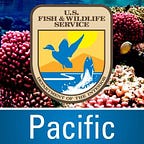Chat With a Scientist: Hawaiian Pollinator Edition
In the early 1900s the yellow-faced bees were some of the most commonly found insects in Hawaiʻi. By the early 2000s they were in sharp decline, and in 2015 seven species of Hawaiian yellow-faced bee were added to the federal Endangered Species List.
We spoke with U.S. Fish and Wildlife Service biologist Dr. Sheldon Plentovich about what makes the Hawaiian yellow-faced bees so special, why they are in trouble, and what you can do to help.
Oʻahu’s north shore may be most famous for its world class surf breaks, but it is also home to some of the best wildlife viewing opportunities in Hawaiʻi.
Spend a day exploring Oʻahu’s north shore and you could find yourself face to face with an endangered Hawaiian monk seal or Hawaiian green sea turtle basking on the beaches
You could visit the albatross colony at Kaʻena Point during fledging season and watch as some of the most magnificent flyers on the planet learn how to use their wings, or you could dip below the surface in one of the north shore’s amazing snorkeling spots and swim with all the fishes.
But hidden away on the eastern corner of the shore is one of the lesser known wildlife communities in Hawaiʻi. There along the quiet coastal strand of James Campbell National Wildlife Refuge is one the last remaining habitats for the endangered Hawaiian Yellow-faced bee, and it’s where Dr. Sheldon Plentovich and scientists from the Hawai’i Department of Land and Natural Resources and the University of Hawaii are working to keep the bees from going extinct.
What is so special about Hawaiian yellow-faced bees?
SP: Hawaiian yellow-faced bees are special because they are Hawaiʻi’s only native bees and all of the species are endemic — meaning that Hawaiʻi is the only place on the planet where they can be found. There are about 60 species of these bees that all descended from a single species ancestor who arrived on the islands approximately one million years ago.
Hawaiian yellow-faced bees can be found in a variety of habitats from coastal to montane environments. They nest in hollow tubes sometimes in soil or rocks on the ground and sometimes in the hollow stems of plants.
The bees depend on healthy intact native plant communities and have struggled to cope with habitat loss and the threats of invasive species.
Non-native plants have pushed out the native plants the bees use for food and habitat, while invasive ants attack the bees nests and exclude the bees from their food source, flowers.
What are the threats to Hawaii’s endangered bees?
SP: Arguably the biggest threat to Hylaeus are invasive ants (and all ants in Hawaiʻi are introduced). Invasive ants have likely shaped the distribution of Hylaeus today. For example, H. anthracinus probably nested on the ground a lot more often in the past. But when the invasive Big-headed ant was introduced to Hawaiʻi, it likely excluded H. anthracinus from places where it had been living.
Now at James Campbell National Wildlife Refuge, H. anthracinus does not nest on the ground because of high densities of big-headed ants and other species. Other threats include habitat loss and competition with introduced bees and wasps
What can people do to help Hawaiʻi’s endangered bees?
SP: One of the biggest things we can do is protect coastal habitat and be aware of where these bees live. H. anthracinus, for example nests in hollow twigs in coastal vegetation, so protecting coastal vegetation in large intact patches is very important. A number of volunteer groups in Hawaiʻi work to protect coastal habitat, so volunteering is another way folks can help get involved.
What is the U. S. Fish and Wildlife studying at James Campbell right now?
SP: We are working on a study to help understand the effects of invasive ants on nesting Hylaeus, and we are testing artificial nest blocks that are designed to prevent the invasive ants from getting in and eating the bee larvae and pupae. We are hoping we can expand the Hylaeus population at James Campbell by improving habitat and providing more nesting opportunities.
How will this research help the bees in the future?
SP: This research could help us understand what kinds of concrete actions we can take to protect Hawaiʻi’s endangered bees. Right now we don’t have a lot of tools to help protect Hyleaus because we know so little about the things that limit their population.
What are some of the more exciting recent discoveries about Hawaiian yellow-faced bees?
SP: There is still a lot to learn about these bees. Earlier this year we found one of the endangered bee species, H. longiceps, at James Campbell National Wildlife Refuge. That particular species had not been on that part of the island in many years so seeing one there was really exciting. These bees have such small and restricted ranges that each patch of habitat is incredibly important.
Just a few weeks later, we discovered a large population of that same species at the Moʻomomi Preserve on Molokaʻi. While we knew that the bees were there, that was the first time we were able to find and see where they nest.
The U. S. Fish and Wildlife Service Coastal Program is working closely with universities and community groups to help understand and protect Hawaiian yellow faced bees and their habitat around the state of Hawaii.
The U.S. Fish and Wildlife Service works with others to conserve, protect, and enhance fish, wildlife, plants, and their habitats for the continuing benefit of the American people. For more information, connect with us through any of these social media channels at https://www.facebook.com/PacificIslandsFWS, www.flickr.com/photos/usfwspacific/, or www.twitter.com/USFWSPacific.
